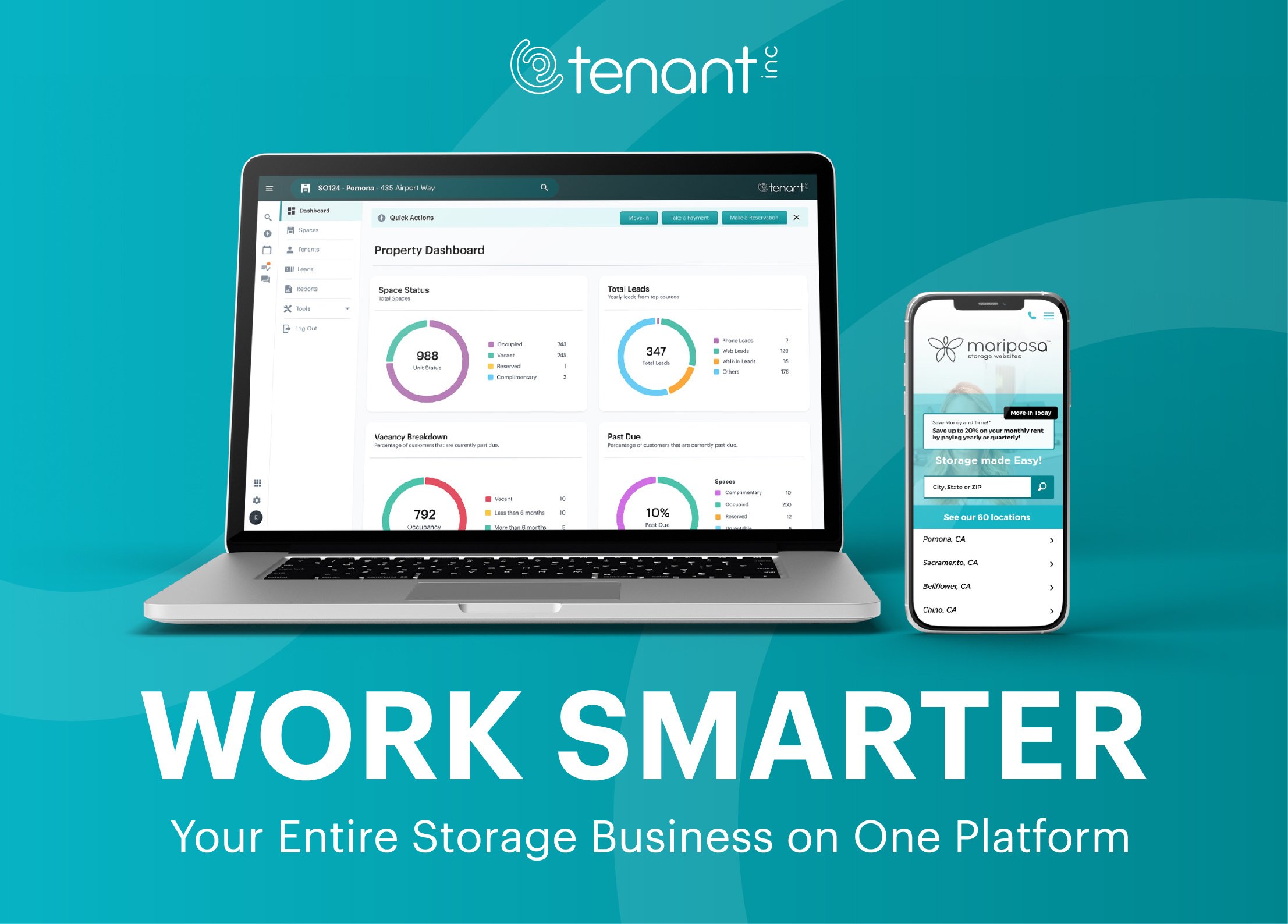Delete Your Doubts: How Sharing Self-Storage Data Benefits Everyone
The old saying “share and share alike” posits that everyone in a group should share an equal amount of something whether it's tangible or intangible. In the self storage industry, that asset is data. Rather than every owner for themself, many believe it’s important to spread the wealth of information so that everyone can make more informed development and operational decisions. The thought is that if everyone shares equally, as the idiom encourages, everyone comes out a winner.
“More transparency is better for all, but it’s hard to get that message across,” says Chris Sonne, Executive Vice President of the Newmark Valuation & Advisory Group. “The challenge is that people don’t want to give up what they believe to be confidential information. What they don’t realize is that a lot of this information is already out there.”
Sonne’s statement echoes what Travis Morrow, President of National Self Storage, wrote in a recent MSM exclusive, The Chicken and the Egg: Cracking the Data Dilemma in Self Storage. “Perhaps these operators fear that by sharing their data they are providing their direct competitors with their ‘secret sauce,” writes Morrow, while noting that any ‘secret’ is likely already exposed online. “Prices and unit sizes are mostly available online to the consumer, and by using digital crawlers to comb through your prices listed on your website and to scrape thousands of websites daily, companies are able to aggregate that data and can track pricing and total square footage across 50,000-plus facilities nationwide.”
Of course, this data may not be the most accurate, and getting your hands on it takes time, money, or both.
Difficulties with Data Collection
Although a lot of self storage data is already available, that doesn’t mean it's always easy to get. “I do primary survey research, and it’s time consuming,” says Sonne. “I go out and inspect properties and talk to managers. I’ll ask if they do competitive research. Many do a quarterly survey, and sometimes you’ll get a manager who will share the information. Other times, they’ve been instructed not to share.”
When that happens, Sonne says he’ll call up someone and have them do a shop. “That’s important because a lot of times the web rates you get through aggregators and crawlers can be different than a walk-in or call rate.”
Jeff Adler, Vice President of Yardi Matrix, the data division of commercial real estate intelligence company Yardi Systems, agrees that data collection is an arduous process. “We released our self storage Matrix product in 2017, but we’d been working on it for three years prior to the release to develop the data,” he explains. “We get some direct feeds from some large storage facilities, but most data collection is brute force work.”
To maintain the most current and accurate data, Adler says he has about 50 employees contributing to the data collection efforts. This type of manpower is necessary because there are tens of thousands of properties, hundreds more in planning and development, and properties are always changing hands which can impact numbers. “The pipeline is always changing, and we don’t cut corners when it comes to data collection. We get the most accurate rents, sales, loans, ownership, management, and new supply information. Some of this is from the internet, some is from phone calls. We talk to people… we talk to a lot of people.”
Bridging the 70/30 Gap
The lack of shared data in the self storage industry has led many operators to look to the REITs when making price and occupancy comparisons or when evaluating market conditions. However, these publicly traded companies only make up about 30 percent of the industry. “The tendency to rely on their data doesn’t even give you half of the story,” says Sonne, while adding that making matters worse for some operators is that there are entire trade areas without REITs.
“What data can they use?” He asks rhetorically. “With many mom-and-pops keeping a lid on their data, and no REITs to speak of, it’s going to be difficult for owners to understand what’s the norm in their market when it comes to financing, operational spending, rents, and more.”
Even when REITs are present, Adler adds, their data can be lacking. “They have to release some data, such as occupancy every quarter by each market they play in. And while they tend to use the internet to advertise pricing, you’re not going to see customer rent increases. Ultimately, they only have to give as much detail as they choose to provide which can lead to inaccurate assumptions.”
Sonne agrees, stating that the physical occupancy reports provided by REITs can be misleading because they don’t factor in economic occupancies. “Just because a property reports 90 percent occupancy, there can be other factors at play,” he explains. “They may really only be at 80 percent because of concessions, accounts receivable challenges… the investment community wants to know what rates a property is really getting, and ask-in, actual, and market rents can all be different.”
To get self storage owners to share their data, specifically the mom-and-pops of the self storage industry, Sonne says the benefits to business owners need to be clear. “Benchmarking, which can be easily done when you’re working with accurate data, has enormous benefits. Owners can see how their operating expenses compare to the market. They can see what concessions others are offering. And they can decide whether they can sharpen their pencil on rents a little.”
Another efficiency that can be improved upon with data sharing is unit mix. “It’s difficult to know the unit mix of a property unless you have a rent roll or occupancy statistics report,” says Sonne. “So let’s say someone is struggling with 5x10s. With data sharing, you may find that the rates you’re offering compared to the competition are way too high. So, you try lowering the rates and voila, occupancy is improved and so is cash flow. You can get that granular if you have the data. And while you can search for ‘10 facilities near me,’ you can’t identify a specific property. Aggregated data offers the anonymity that’s so important to owners.”
Sonne also says that more transparency also benefits owners when it comes to financing. “Having accurate information is very helpful when transacting with a bank or lender,” he explains. “Plus, everyones debt comes due at least every 10 years. If there’s a robust database available and you can provide market information to your banker, this will assist in their underwriting and the quality of credit you receive. So while you may not think about this sort of thing every day, having that transparency does benefit you in the long run too.”
Ultimately, the majority of research supports data sharing for better business outcomes. “The traditional ‘don’t share data unless’ mindset should be replaced with ‘must share data unless,’” writes Gartner Research. “By recasting data sharing as a business necessity, data and analytics leaders will have access to the right data at the right time, enabling more robust data and analytics strategies that deliver business benefits.”
Morrow notes that the value of data from one facility, in one market, is essentially useless except to that owner. Instead, the value of shared data is derived from scale, which can be achieved anonymously, putting to bed concerns about giving up confidential information.
Debunking Data Sharing Concerns
Adler says that there’s a deep concern among some owners that sharing rents would lead to accusations of price fixing within the industry. He points to the current lawsuits leveled against technology company RealPage, Inc. of conspiring with multifamily residential property managers to keep rental prices artificially high. The complaints allege that defendants in the price-fixing scheme used a revenue management software program, made by RealPage, to unlawfully coordinate on pricing and vacancy.
“The self storage industry is less sensitive to this type of thing than housing, but it’s still a concern,” says Adler. “Rents are already online, but any move to further consolidate collection of that data comes with some risk of price collusion.”
Adam Wagner, President of Superior Storage, doesn’t see it this way. “Collusion to me is asking other facilities what they’re charging and then agreeing not to go above or below a certain amount. All we do is look at pricing models and trends in our area to maximize our investments,” he says “This is no different than what the housing market does. When you’re selling a home, you look at what other homes sold for in the neighborhood per square foot to determine what you’re going to sell your house at per square foot.”
Continues Wagner, “It’d be a different story if everyone in a housing market said, ‘Okay don’t sell below $250 a foot,’ but that’s not what’s going on.”
Adler says that to be safe, pricing information should never be collected daily (something Yardi does not do). “You can’t use external data for the purpose of setting prices regularly,” he says. “Monthly or quarterly is okay for benchmarking and valuation purposes. If you’re just using it for that, there’s nothing to worry about.”
Wagners Words of Wisdom
Although he's a relative newcomer to the self storage industry, Wagner dived in with both feet in 2019 and now operates five facilities throughout Texas. From the beginning, he has been a proponent of data sharing. “In order to make things run smoothly, you’ve got to share data,” he says. “Your data can be captured if someone wants it anyhow, so there’s no reason not to share. It doesn’t make sense.”
Sharing data ultimately makes the end-user experience better, says Wagner, because owners can begin to use the information to better understand the needs of customers and tenants. A recent article from Forbes follows this same line of thought: “Businesses that harness the power of a large, communal pool of data can expect to provide more customer value because users of the data more fully understand their customers’ needs, and in turn to foster a more loyal and satisfied customer base.”
Wagner says that Superior Storage currently shares its data through their revenue management system, with everything from current specials to occupancy data being fair game. “Anything pertinent to our locations they have,” he says. “In turn, they help us make pricing decisions based on occupancies in the area and so on.”
Competing with REITs is another big benefit of data sharing for independents, says Wagner. However, he acknowledges that many mom-and-pops are scared to share and like to keep their data close to their chests. Once common argument for the reluctance to share that he hears a lot is that if the REITs have independent owners’ data, they’ll use it against them. For example, they may move into a market and set up shop next to an independent because data showed it was at 98 percent occupancy, signifying demand in the area.
“Of course, they’re going to do that anyhow,” laughs Wagner, who acknowledges that publicly traded companies are great at getting intel because they’re typically more sophisticated with more resources at their disposal. “But, if the 70 percent of mom-and-pops can join together to share data with one another, we can compete more effectively with them.”
For Data Sharing, The Time Is Now
The idea of sharing data in self storage is not a new one. “We’ve been trying this for decades,” says Sonne, who also contributes to the Self-Storage Almanac, published annually by MSM, which gives the demand per person in the United States and then drills down to individual markets. “People didn’t want to be bothered, they looked at it as just one more thing to do because a lot of the data would have to be inputted manually.”
Adler says that they’ve also considered data sharing initiatives in the past. “We’ve thought about ways to get people to share data before,” he says. “We thought ‘let’s have a website and everyone can contribute their rents and occupancies on a monthly basis… we’ll assemble the data, and whoever contributes gets access to it for free, and whoever doesn’t has to pay for it.’ So, we floated the idea around to REITs, independents… no one wanted it. ‘Not interested,’ they said.”
Continues Adler, “In the end, they perceived that the benefit of lack of transparency exceeded the benefits of transparency.”
One data sharing initiative that briefly got off the ground in 2011 was a partnership between the national Self Storage Association (SSA) and New York-based Real Estate Investment Services (REIS), a leading provider of commercial real estate market information and analytics. Together, the organizations would collect and analyze information about historic operations and performance, and then make that information available to Association members and the investment community.
Unfortunately, things didn’t work out as intended. “Sometimes, great ideas come too early,” writes Morrow, who states that the process, at the time, was too cumbersome for operators to adopt on a wide scale. But that’s all changed with the proliferation of property management software, which has moved data to the cloud.
“The cloud makes the sharing of data easier… It would allow operators to share their data anonymously with data services of their choosing… It’s as simple as turning on a “switch” for the operator,” Morrow writes, stating that the next step is to convince project management software companies to create the switch.
MSM has spoken with numerous project management software companies in the self storage industry, and although only one has this capability built in, all agree that creating it would be fairly simple – they just want to first understand more about their customers’ data needs. To help facilitate these conversations, take the survey below.
–
Brad Hadfield is the web manager and news writer for MSM.
More Content
Popular Posts
Recent Posts
In April 1984, the first non-stop commercial...
Raise your hand if you’ve ever made plans,...
Everyone knows it: Investing in real estate...
They say when one door closes, another one...
Like its name implies, Surprise, Ariz., a...
Self-storage has become as reliant on the...
Having a strong online presence is...
Social media and search engine...











